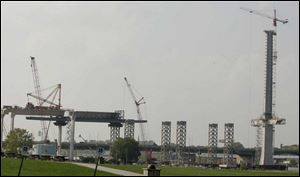
I-280 bridge workers to top it off
10/17/2005
Work begins today to add three concrete pieces to the top of the towering central support for the I-280 Veterans' Glass City Skyway.
From a caisson hole 32 feet below the Maumee River's bed, ironworkers, carpenters, concrete masons, and other workers during the past 39 months have raised a tower to nearly 400 feet above the water.
Beginning today, the tower's apex will be added: three precast concrete pieces that together will form the pyramid-like top of the pylon that soon will hold up the cable stays for the I-280 Veterans' Glass City Skyway bridge.
A ceremony at the construction site will mark the occasion this morning, though Mike Gramza, a project manager for the Ohio Department of Transportation, said the last of the three pieces probably won't be hoisted up to the tower's top for a day or two.
While several future events, including completion of the first main span over the Maumee's shipping channel and the first lighting of the pylon's inlaid glass panels, will be more spectacular, "this is a substantial milestone," Mr. Gramza said.
Of the project's $220 million cost, the pylon represents about $27 million, ODOT figures show.
It has been built with 11,627 cubic yards of concrete and 1.83 million pounds of reinforcing steel. Seventeen foundation shafts were drilled 15 feet into bedrock below the structure, anchoring a concrete base 16 feet thick and 104 feet in diameter and containing 5,400 cubic yards of concrete and 800,000 pounds of steel.
The pylon leans a very little bit - one inch from bottom to top.
That's because the bridge's weight on the north side of the tower will be somewhat heavier than on the south side, Mr. Gramza said. By building the pylon to lean that slight bit to the south, he said, the extra load will straighten it up over the first 10 years after the structure's completion.
Each tip section will be 13 1/2 feet tall and weigh 10,500 to 11,000 pounds. They contain four aviation beacons, though those won't be lighted right away - for now, Mr. Gramza said, required safety lighting is provided on the construction crane being used to erect the pylon.
Before the bridge is finished, of course, the pylon's lighting will go beyond a few red blinking lamps for airplanes. Inlaid glass paneling 7 feet wide and 185 feet tall is to be installed on the pylon's four faces, with each quadrant internally lit by light-emitting diodes. The three primary colors will be in each diode array, allowing "infinite color options," ODOT said.
While the pylon structure is nearly complete, the bridge deck has far to go. Three trusses - two overhead gantries and one underslung, scaffold-like structure - are in use to assemble prefabricated segments of the bridge's deck. At the channel it will be 135 feet above the water.
Officials from ODOT and the contractor, Fru-Con Construction of Ballwin, Mo., originally hoped to have the bridge done seven weeks ago. That schedule was dashed by a Feb. 16, 2004, crane collapse that killed four construction workers, injured four others, and was followed by nearly 16 months of deck-assembly delays while engineers revised the construction plans.
The revisions included abandoning the concept of building portions of the bridge over the existing I-280 with live traffic underneath. Instead, I-280 will be closed between Summit Street and Greenbelt Parkway, starting at 7 a.m. tomorrow, for an estimated seven months.
That closing could be broken into two stretches, depending on winter weather, and future closings of shorter duration are to be scheduled in East Toledo too.
Contact David Patch at: dpatch@theblade.com or 419-724-6094.